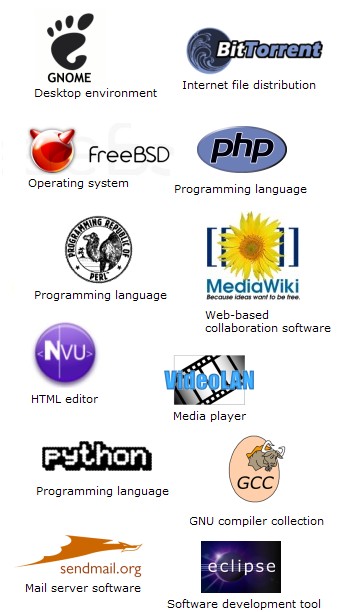Difference between revisions of "Free and open-source software"
m (Open source moved to Open source software) |
|||
| Line 1: | Line 1: | ||
| − | [[Image:OS logos1.jpg|right]] | + | [[Image:OS logos1.jpg|right|Some open source software projects]] |
| − | [[Image:OS logos2.jpg|right]] | + | [[Image:OS logos2.jpg|right|Some open source software projects]] |
'''Open source''' is a software development model involving loose networks of people connected by the internet who collaborate to create and evolve software that is also made freely available for anyone to use. Not only is the end product available to all but the [http://en.wikipedia.org/wiki/Source_code source code] used to create it is also free to view and modify. This is the code that commercial software firms normally keep secret. | '''Open source''' is a software development model involving loose networks of people connected by the internet who collaborate to create and evolve software that is also made freely available for anyone to use. Not only is the end product available to all but the [http://en.wikipedia.org/wiki/Source_code source code] used to create it is also free to view and modify. This is the code that commercial software firms normally keep secret. | ||
Revision as of 01:43, 28 November 2005
Open source is a software development model involving loose networks of people connected by the internet who collaborate to create and evolve software that is also made freely available for anyone to use. Not only is the end product available to all but the source code used to create it is also free to view and modify. This is the code that commercial software firms normally keep secret.
Making source code available means anyone with the ability can customize the software, spot flaws and improve it. Usually the improvements are made available too, creating a positive feedback loop in the software's evolution. Open Source is becoming a very prominent method of software production and poses a serious challenge to commercial products.
What goes around comes around
If the software is useful to many people then there is a wide audience who are able to spot and report problems, and even fix them. People are motivated to contribute because the result of their work benefits many people. Someone putting in effort on an open-source software project knows there are people of a similar mind-set putting in effort elsewhere that will be useful to them also. What goes around comes around.
Maximum utility
The fact that thousands of other people are able to make use of the software having put in no effort themselves and haven't paid any money simply isn't an issue - after all it costs nothing to replicate the software and the open-source developers are only too happy that it is proving useful to a wider audience. It is truly maximizing it's utility.
Because of the mutual benefits, open source projects encourage collaboration on an almost unheard of scale, as well as promoting rapid evolution and stability of the applications being developed (one might normally consider the last two properties as being mutually exclusive). There are now high quality open source projects filling every major category of software application, including entire operating systems.
External links
- http://en.wikipedia.org/wiki/List_of_open_source_software
- http://www.linux.org Open source operating system
- http://www.OpenOffice.org Open source office productivity software
- http://www.mozilla.org/products/firefox Open source web browser
- http://www.fsf.org/ website of the Free software foundation (FSF)
- http://www.opensource.org/OSI website of the Open Source Initiative (OSI)

